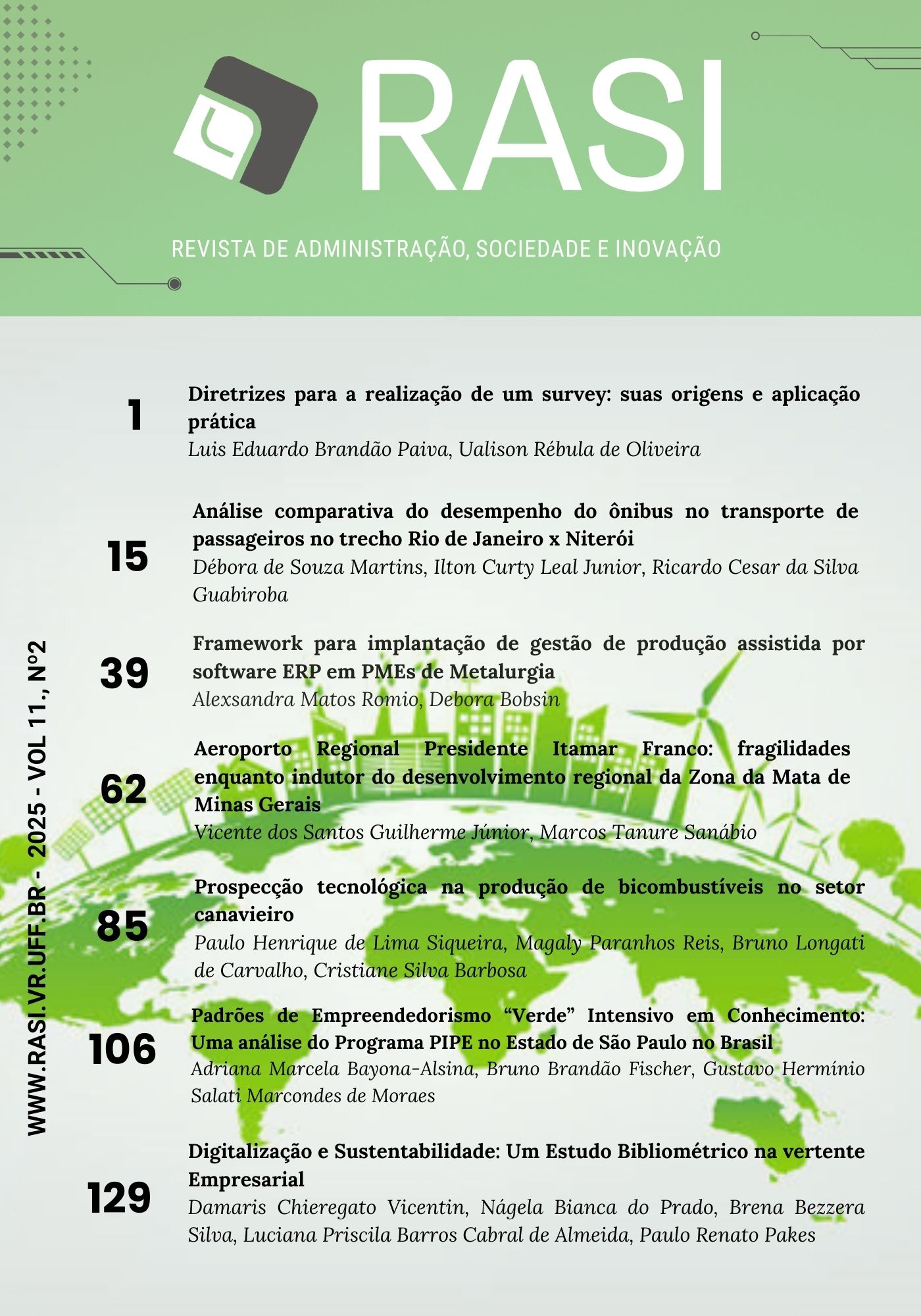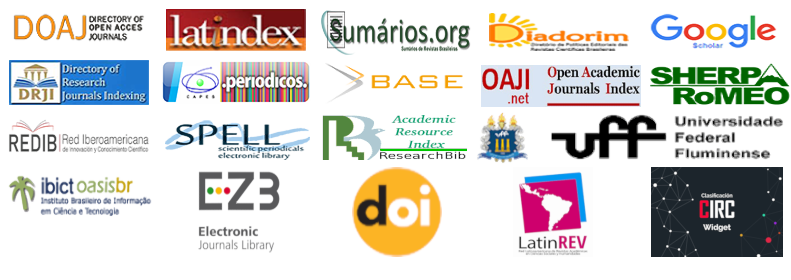ERP Software-Assisted Framework for Production Management Implementation
DOI:
https://doi.org/10.20401/rasi.11.2.718Keywords:
Enterprise Resource Planning (ERP), Small and Middle Enterprise (SME), Integrated Management Systems, Software Framework ImplementationAbstract
Enterprise Resource Planning (ERP) systems play a crucial role in metallurgy Small and medium-sized enterprises (SME) organizational decision-making by integrating information through software and driving structural transformations. This study aims to develop a framework to guide the implementation of ERP-based production management systems in small and medium-sized industrial companies. Exploring the benefits and particularities of ERPs, a qualitative approach and the Design Science Research research method were adopted. The study began with a literature review to identify the main ERP implementation models and, from there, a framework was created that combines elements of these existing models. In addition, action research in an old small-scale metalworking industry was used to identify gaps in previous models. The framework was then designed and evaluated by experts, undergoing necessary adjustments. This research contributes both theoretically, by supporting theories on system implementation, and in practice, by providing a guide in the form of a framework with flowcharts and checklists to assist companies in their development.
Downloads
References
Azevedo, R. C., Bremer, C. F., Rebelatto, D. A. N., & Tarallo, F. B. (2006). O uso de ERP e CRM no suporte à gestão da demanda em ambientes de produção Make-to-Stock. Gestão & Produção, 13, 179–190. http://www.scielo.br/scielo.php?script=sci_arttext&pid=S0104-530X2006000200002&lang=pt
Bittighofer, D., Dust, M., Irslinger, A., Liebich, M., & Martin, L. (2018). State of Industry 4.0 across German Companies A Pilot Study. 2018 IEEE International Conference on Engineering, Technology and Innovation (ICE/ITMC). https://doi.org/10.1109/ICE.2018.8436246
Carvalho, R. A., & Campos, R. (2009). Uma análise de aspectos relacionados ao desenvolvimento e adoção de Enterprise Resources Planning livre de código aberto. Gestão & Produção, 16, 667–678. http://www.scielo.br/scielo.php?script=sci_arttext&pid=S0104-530X2009000400014&lang=pt
Castro, N., Borges, A. M., Baquero, N., & Rodríguez, S. (2006). Modelo para la selección de software ERP: el caso de Venezuela. Revista de La Facultad de Ingeniería Universidad Central de Venezuela, 21, 125–137. http://ve.scielo.org/scielo.php?script=sci_arttext&pid=S0798-40652006000100012&lang=pt
Chung, S. H., Tang, H. L., & Imtiaz, A. (2011). Modularity, Integration and IT Personnel Skills Factors in Linking ERP to SCM Systems. Journal of Technology Management Innovation, 6, 1–3. http://www.scielo.cl/scielo.php?script=sci_arttext&pid=S0718-27242011000100001&lang=pt
Coleman, S., Goeb, R., Manco, G., Pievatolo, A., Tort-Martorell, X., & Reis, M. S. (2016). How Can SMEs Benefit from Big Data? Challenges and a Path Forward. Quality and Reliability Engineering International, 32(6), 2151–2164. https://doi.org/10.1002/qre.2008
Corrêa, H. L., Gianesi, I. G. N., & Caon, M. (2018). Planejamento, Programação e Controle da Produção - MRP II / ERP (6a edição). Atlas.
Correa, J., & Spinola, M. de M. (2015). Adoção, seleção e implantação de um ERP livre. Production, 25, 956–970. http://www.scielo.br/scielo.php?script=sci_arttext&pid=S0103-65132015000400956&lang=pt
Dresch, A., Lacerda, D. P., & Antunes Júnior, J. A. V. (2015). Design Science Research: Método de pesquisa para avanço da ciência e tecnologia. Bookman.
Fettermann, D. C., Cavalcante, C. G. S., Almeida, T. D., & Tortorella, G. L. (2018). How does Industry 4.0 contribute to operations management? Journal of Industrial and Production Engineering, 35(4), 255–268. https://doi.org/10.1080/21681015.2018.1462863
Gambôa, F. A. R., Caputo, M. S., & Bresciani Filho, E. (2004). Método para gestão de riscos em implementações de sistemas ERP baseado em fatores críticos de sucesso. JISTEM - Journal of Information Systems and Technology Management, 1, 45–62. http://www.scielo.br/scielo.php?script=sci_arttext&pid=S1807-17752004000100004&lang=pt
Giacon, E., & Mesquita, M. A. (2011). Levantamento das práticas de programação detalhada da produção: um survey na indústria paulista. Gestão & Produção, 18, 487–498. http://www.scielo.br/scielo.php?script=sci_arttext&pid=S0104-530X2011000300004&lang=pt
Gripe, F. G. S., & Rodello, I. A. (2011). A theoretical analysis of key points when choosing open source erp systems. JISTEM - Journal of Information Systems and Technology Management, 8, 441–458. http://www.scielo.br/scielo.php?script=sci_arttext&pid=S1807-17752011000200010&lang=pt
Hart C. A., S. D. R. (2014). The organisational performance impact of ERP systems on selected companies. South African Journal of Industrial Engineering, 25, 14–28. http://www.scielo.org.za/scielo.php?script=sci_arttext&pid=S2224-78902014000100003&lang=pt
Jesus, R. G., & Oliveira, M. O. F. (2006). Implantação de sistemas ERP: tecnologia e pessoas na implantação do SAP R/3. JISTEM - Journal of Information Systems and Technology Management, 3, 315–329. http://www.scielo.br/scielo.php?script=sci_arttext&pid=S1807-17752006000300004&lang=pt
Krainer, C. W. M., Krainer, J. A., Iarozinski Neto, A., & Romano, C. A. (2013). Análise do impacto da implantação de sistemas ERP nas características organizacionais das empresas de construção civil. Ambiente Construído, 13, 117–135. http://www.scielo.br/scielo.php?script=sci_arttext&pid=S1678-86212013000300008&lang=pt
Laurindo, F. J. B., & Mesquita, M. A. (2000). Material Requirements Planning: 25 anos de história - Uma revisão do passado e prospecção do futuro. Gestão & Produção, 7, 320–337. http://www.scielo.br/scielo.php?script=sci_arttext&pid=S0104-530X2000000300009&lang=pt
Lavelli, A. F., Lima, P. F., Piratelli, C. L., Escrivão Filho, E., Mazzali, L., & Costa, V. M. H. de M. (2021). Utilização de Tecnologia da Informação por Micro e Pequenas Empresas: Estudo do Setor de Cerâmica Artística e de Decoração de Município do Estado de São Paulo. Revista de Administração, Sociedade e Inovação, 7(3), 104–122. https://doi.org/10.20401/rasi.7.3.484
Macêdo, D. G., Gaete, L., & Joia, L. A. (2014). Antecedentes à resistência a sistemas empresariais: a perspectiva de gestores brasileiros. Revista de Administração Contemporânea, 18, 139–160. http://www.scielo.br/scielo.php?script=sci_arttext&pid=S1415-65552014000200003&lang=pt
Mariano, A. M., & Santos, M. R. (2017). Revisão da Literatura: Apresentação de uma Abordagem Integradora. XXVI Congreso Internacional de La Academia Europea de Dirección y Economía de La Empresa (AEDEM), 26(September), 427–443.
Martins, R. A. (2010). Princípios de Pesquisa Científica. In P. A. C. M. (Organizador) (Ed.), Metodologia de pesquisa em engenharia de produção e gestão de operações, (pp. 5–30). Elsevier : ABEPRO.
Martins, W. S., Kuehne, B. T., Sobrinho, R. F., & Preti, F. (2020). A Reference Method for Performance Evaluation in Big Data Architectures. 2020 IEEE 13TH International Conference on Services Computing (SCC 2020), 280–287. https://doi.org/10.1109/SCC49832.2020.00044
Masood, T., & Sonntag, P. (2020). Industry 4.0: Adoption challenges and benefits for SMEs. Computers in Industry, 121, 1–12. https://doi.org/10.1016/j.compind.2020.103261
Medeiros, I. L., Vieira, A., Braviano, G., & Gonçalves, B. S. (2015). Revisão Sistemática e Bibliometria facilitadas por um Canvas para visualização de informação. InfoDesign - Revista Brasileira de Design da Informação, 12(1), 93–110. https://infodesign.emnuvens.com.br/infodesign/article/view/341/213
Mendes, J. V., & Escrivão Filho, E. (2007). Atualização tecnológica em pequenas e médias empresas: proposta de roteiro para aquisição de sistemas integrados de gestão (ERP). Gestão Produção, 14, 281–293. http://www.scielo.br/scielo.php?script=sci_arttext&pid=S0104-530X2007000200007&lang=pt
Menezes, P. A. C., & González-Ladrón-de-Guevara, F. (2010). Maximización de los beneficios de los sistemas ERP. Revista de Gestão Da Tecnologia e Sistemas de Informação, 7(1), 05–32.
Méxas, M. P. P., Costa, H. G., & Quelhas, O. L. G. (2013). Avaliação da importância relativa dos critérios para a seleção de Sistemas Integrados de Gestão (ERP) para uso em empresas da construção civil. Gestão Produção, 20, 337–356. http://www.scielo.br/scielo.php?script=sci_arttext&pid=S0104-530X2013000200007&lang=pt
Moeuf, A., Lamouri, S., Pellerin, R., Tamayo-Giraldo, S., Tobon-Valencia, E., & Eburdy, R. (2020). Identification of critical success factors, risks and opportunities of Industry 4.0 in SMEs. International Journal of Production Research, 58(5), 1384–1400. https://doi.org/10.1080/00207543.2019.1636323
Neto, J. V. O. (2005). O impacto sobre a informação contábil após a implementação de um sistema integrado de gestão nas instituições federais de ensino superior. Revista de Gestão Da Tecnologia e Sistemas de Informação, 2(1), 39–54.
Oliveira, C. E., & Avellar, A. P. M. de. (2021). Evidências da Relação entre Inovação Organizacional e Inovação Tecnológica na Indústria Brasileira. Revista de Administração, Sociedade e Inovação, 7(3), 9–29. https://doi.org/10.20401/rasi.7.3.463
Oliveira, L. S., & Hatakeyama, K. (2012). Um estudo sobre a implantação de sistemas ERP: pesquisa realizada em grandes empresas industriais. Production, 22, 596–611. http://www.scielo.br/scielo.php?script=sci_arttext&pid=S0103-65132012000300018&lang=pt
Padilha, T. C. C., Costa, A. F. B., Contador, J. L., & Marins, F. A. S. (2004). Tempo de implantação de sistemas ERP: análise da influência de fatores e aplicação de técnicas de gerenciamento de projetos. Gestão Produção, 11, 65–74. http://www.scielo.br/scielo.php?script=sci_arttext&pid=S0104-530X2004000100006&lang=pt
Padilha, T. C. C., & Marins, F. A. S. (2005). Sistemas ERP: características, custos e tendências. Production, 15, 102–113. http://www.scielo.br/scielo.php?script=sci_arttext&pid=S0103-65132005000100009&lang=pt
Perez, G., & Ramos, I. (2013). Understanding organizational memory from the Integrated Management Systems (ERP). JISTEM - Journal of Information Systems and Technology Management, 10, 541–560. http://www.scielo.br/scielo.php?script=sci_arttext&pid=S1807-17752013000300541&lang=pt
Provdanov, C. C., & Freitas, E. C. (2013). Metodologia do trabalho científico: métodos e técnicas da pesquisa e do trabalho acadêmico. In Novo Hamburgo: Feevale (2nd ed.). Universidade Feevale. https://doi.org/10.1017/CBO9781107415324.004
Scholtz, B. M., Kapeso, M., & Villiers, M. R. (2017). The usefulness and ease of use of a mobile simulation application for learning of ERP systems. South African Computer Journal, 29, 87–105. http://www.scielo.org.za/scielo.php?script=sci_arttext&pid=S2313-78352017000200006&lang=pt
Silva, F. P. C., & Pereira, N. A. (2006). Modelagem de processos de negócios na implementação de ERPs nacionais em PMEs. Production, 16, 341–353. http://www.scielo.br/scielo.php?script=sci_arttext&pid=S0103-65132006000200013&lang=pt
Sousa, A. M. H., & Barros Neto, J. P. (2020). Is it possible to implement ERP in the production function of civil construction? Gestão Produção, 27. http://www.scielo.br/scielo.php?script=sci_arttext&pid=S0104-530X2020000300203&lang=pt
Souza, C. A., & Zwicker, R. (2003). Big-bang, small-bangs ou fases: estudo dos aspectos relacionados ao modo de início de operação de sistemas ERP. Revista de Administração Contemporânea, 7, 9–31. http://www.scielo.br/scielo.php?script=sci_arttext&pid=S1415-65552003000400002&lang=pt
Valentim, O. A., Politano, P. R., Pereira, N. A., & Araújo Filho, T. (2014). Análise comparativa entre a implementação e atualização do sistema ERP R/3 da SAP considerando os fatores críticos de sucesso descritos na literatura: um estudo de caso em uma empresa do segmento de bebidas. Gestão Produção, 21, 111–124. http://www.scielo.br/scielo.php?script=sci_arttext&pid=S0104-530X2014000100008&lang=pt
Yahiaoui, S., Fedouaki, F., & Mouchtachi, A. (2019). A Supply Chain Maturity Model for automotive SMEs: a case study. IFAC Papersonline, 52(13), 2044–2049. https://doi.org/10.1016/j.ifacol.2019.11.506
Downloads
Published
Issue
Section
License
Copyright (c) 2025 Review of Administration, Society and Innovation

This work is licensed under a Creative Commons Attribution 4.0 International License.
RASI, in accordance with Law No. 9,610 of February 19, 1998, which amends, updates and consolidates Brazilian copyright law and makes other provisions, adopts the following conditions of the Copyright Assignment:
1. RASI maintains, with the transfer of copyrights, the possession of rights over the content published;
2. The author retains his moral rights of the content, including the right to be identified as the author whenever the content is published;
3. Despite the attribution of copyright, the author retains the right to reuse the material in future collections of his own work without encumbrance. The acknowledgments of the previous publication in the RASI are the only requirements in such cases;
4. The author may make photocopies of the content, or distribute it by electronic mail or fax, provided that they are intended for their own classes and for the purpose of meeting research objectives, provided that: (a) such copies are not resold and (b) reference to the original source of the publication and the name of the RASI are clearly indicated on all copies made of the document.











